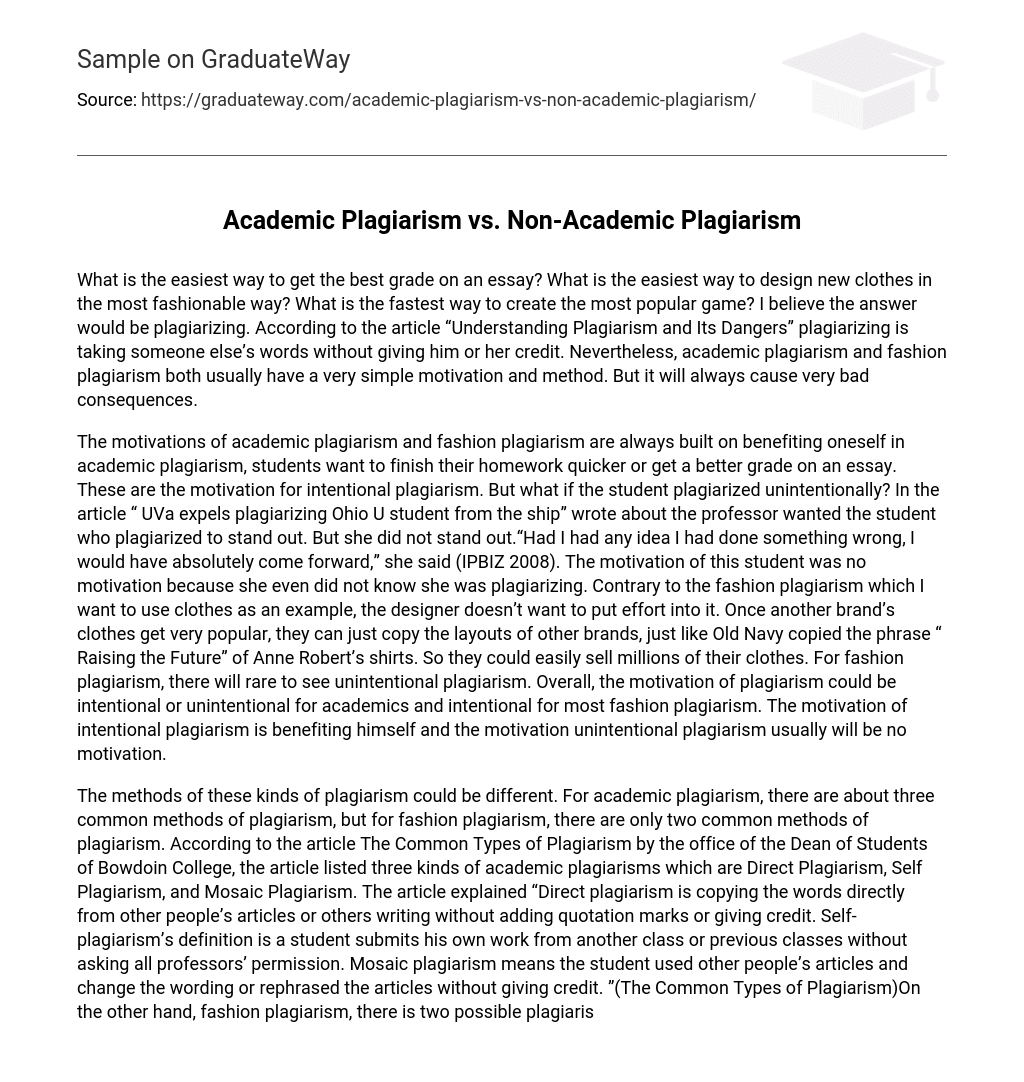What is the easiest way to get the best grade on an essay? What is the easiest way to design new clothes in the most fashionable way? What is the fastest way to create the most popular game? I believe the answer would be plagiarizing. According to the article “Understanding Plagiarism and Its Dangers” plagiarizing is taking someone else’s words without giving him or her credit. Nevertheless, academic plagiarism and fashion plagiarism both usually have a very simple motivation and method. But it will always cause very bad consequences.
The motivations of academic plagiarism and fashion plagiarism are always built on benefiting oneself in academic plagiarism, students want to finish their homework quicker or get a better grade on an essay. These are the motivation for intentional plagiarism. But what if the student plagiarized unintentionally? In the article “ UVa expels plagiarizing Ohio U student from the ship” wrote about the professor wanted the student who plagiarized to stand out. But she did not stand out.“Had I had any idea I had done something wrong, I would have absolutely come forward,” she said (IPBIZ 2008). The motivation of this student was no motivation because she even did not know she was plagiarizing. Contrary to the fashion plagiarism which I want to use clothes as an example, the designer doesn’t want to put effort into it. Once another brand’s clothes get very popular, they can just copy the layouts of other brands, just like Old Navy copied the phrase “ Raising the Future” of Anne Robert’s shirts. So they could easily sell millions of their clothes. For fashion plagiarism, there will rare to see unintentional plagiarism. Overall, the motivation of plagiarism could be intentional or unintentional for academics and intentional for most fashion plagiarism. The motivation of intentional plagiarism is benefiting himself and the motivation unintentional plagiarism usually will be no motivation.
The methods of these kinds of plagiarism could be different. For academic plagiarism, there are about three common methods of plagiarism, but for fashion plagiarism, there are only two common methods of plagiarism. According to the article The Common Types of Plagiarism by the office of the Dean of Students of Bowdoin College, the article listed three kinds of academic plagiarisms which are Direct Plagiarism, Self Plagiarism, and Mosaic Plagiarism. The article explained “Direct plagiarism is copying the words directly from other people’s articles or others writing without adding quotation marks or giving credit. Self-plagiarism’s definition is a student submits his own work from another class or previous classes without asking all professors’ permission. Mosaic plagiarism means the student used other people’s articles and change the wording or rephrased the articles without giving credit. ”(The Common Types of Plagiarism)On the other hand, fashion plagiarism, there is two possible plagiarism because there is no self-plagiarism. Due to the Law Of Diminishing Marginal Utility, a customer consumes one good at the first, the utility will be highest, along the customer keep consuming the same good, the marginal utility will starting diminishing. In other words, the firms will not self-plagiarising because they will not get profit from it. The two methods left are direct plagiarism and mosaic plagiarism, and the procedures of these are pretty much the same as academic plagiarism. The firms can simply change the colors of the shirts or not change anything at all. Overall, the methods between academic plagiarism and fashion plagiarism are different because you will not submit one essay twice to one professor but the firm will sell the clothes many times to one consumer.
The consequences of these two kinds of plagiarism are extremely different in America. According to the IVC’s campus policies “Academic Honesty and Dishonesty.” it states that “Disciplinary actions range from a verbal reprimand to a written reprimand, to disciplinary probation, to suspension, to expulsion.” The statements on the website are very vague because the consequences will depend on your professor and the officers at IVC. But usually, the consequences will not just be a verbal reprimand or a written reprimand. You probably will get dropped from the course or expelled from my personal experiences. But the consequences of fashion plagiarism will be so much easier to bear because there was no law to prevent fashion plagiarism. According to the article “Fashion brands steal design ideas all the time. And it’s completely legal.” it says “American law doesn’t forbid brands from duplicating each other brands can continue replicating each other on account of obsolete lawful regulations.”(Lieber 2018) In brief, the consequences between academic plagiarism and fashion plagiarism are huge. One is a serious issue and the other one is not a big deal because we do not have a law to prevent fashion plagiarism.
Overall, compare academic plagiarism fashion plagiarism, the differences could be huge. But the motivation will always be based on the benefits of themselves. Also, the methods are similar. Most of them are direct plagiarism or just change a little bit. In addition, the people who plagiarized and get caught will usually get consequences, but on the fashion plagiarism, they will not get punished by law. This is the biggest difference between academic plagiarism and fashion plagiarism. Solutions for academic plagiarism could be develope more advanced technology to discriminate the similarity such as the website called Turnitin. And the solutions for fashion plagiarism could be establish the law to prevent firms from copying each other’s design.





